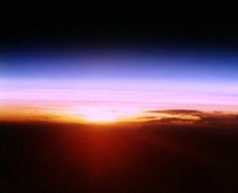|
Our atmosphere is a mixture of gases that surround Earth. It is kept in place by the pull of Earth's gravity. If Earth was
a much smaller planet, like Mercury or Pluto, its gravity would be to weak to hold a large atmosphere.

Here's a great picture of our atmosphere.
Here's everything you ever wanted to know about the atmosphere.
The Layers of the Atmosphere:
THERMOSPHERE: The thermosphere is a thermal classification of the atmosphere. In the thermosphere, temperature increases
with altitude. The thermosphere includes the exosphere and part of the ionosphere.
EXOSPHERE: The exosphere is the outermost layer of the Earth's atmosphere. The exosphere goes from about 400 miles (640
km) high to about 800 miles (1,280 km). The lower boundary of the exosphere is called the critical level of escape, where
atmospheric pressure is very low (the gas atoms are very widely spaced) and the temperature is very low.
IONOSPHERE: The ionosphere starts at about 43-50 miles (70-80 km) high and continues for hundreds of miles (about 400
miles = 640 km). It contains many ions and free electrons (plasma). The ions are created when sunlight hits atoms and tears
off some electrons. Auroras occur in the ionosphere.
MESOSPHERE: The mesosphere is characterized by temperatures that quickly decrease as height increases. The mesosphere
extends from between 31 and 50 miles (17 to 80 kilometers) above the earth's surface.
STRATOSPHERE: The stratosphere is characterized by a slight temperature increase with altitude and the absence of clouds.
The stratosphere extends between 11 and 31 miles (17 to 50 kilometers) above the earth's surface. The earth's ozone layer
is located in the stratosphere. Ozone, a form of oxygen, is crucial to our survival; this layer absorbs a lot of ultraviolet
solar energy. Only the highest clouds (cirrus, cirrostratus, and cirrocumulus) are in the lower stratosphere.
TROPOPAUSE: The tropopause is the boundary zone (or transition layer) between the troposphere and the stratosphere. The
tropopause is characterized by little or no change in temperature altitude increases.
TROPOSPHERE: The troposphere is the lowest region in the Earth's (or any planet's) atmosphere. On the Earth, it goes from
ground (or water) level up to about 11 miles (17 kilometers) high. The weather and clouds occur in the troposphere. In the
troposphere, the temperature generally decreases as altitude increases.
|

